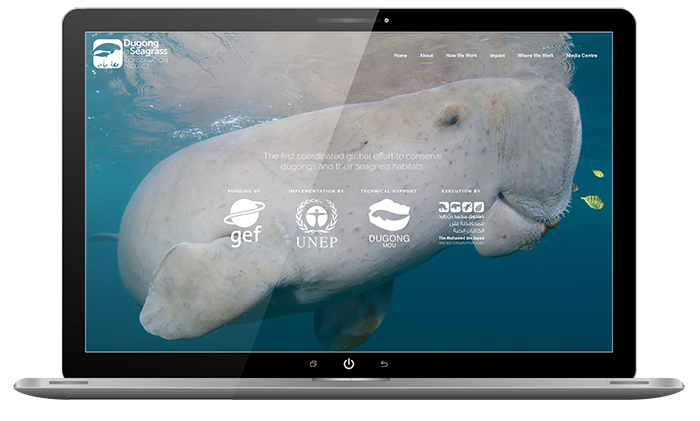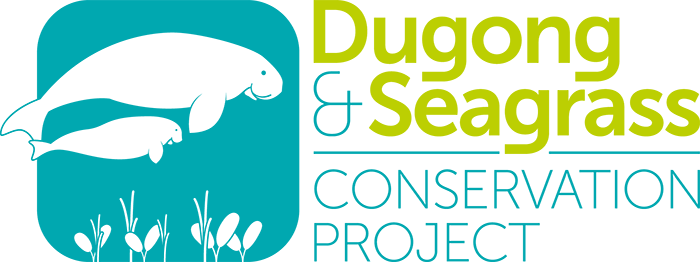This project funded by GEF and implemented by UNEP is the first coordinated worldwide effort to conserve dugongs and their seagrass habitats. It aims to introduce conservation priorities into national and regional policies & planning.
Heard of manatees but not dugongs? Likewise, seaweed but not seagrass? There are some astonishing facts that don’t seem to be in the public awareness. Since the 1980s we’ve been losing two football fields of seagrass per hour! We couldn’t wait to get involved.
Project scope
This project encompassed a complete understanding of their needs to build a website and work in collaboration with a number of organisations. Overall execution of the project is managed by MBZ in partnership with the Secretariat of the UNEP Convention on Migratory Species’ Dugong Memorandum and under supervision of UNEP and GEF. The overall goal of the project is to improve the conservation status of dugongs and their seagrass habitats across the Indian and Pacific Ocean basins.
The DSCP team provided a brief with specific objectives for their website that would help them achieve their goal. They wanted a way to encourage community involvement in, and responsibility for, targeted protected areas. This included encouraging sustainable fisheries practices among local fishing communities. They also wanted to remove barriers to the knowledge needed for effective conservation. Further, they wanted to incorporate dugong and seagrass conservation priorities and measures into national and regional policy, planning and regulatory frameworks.
With all these organisational objectives set out, to put it simply … they wanted a website that would communicate and facilitate these requirements.
Project Outome
We engaged input from the numerous organisations that were involved and had the benefit of working with well organised key contacts that were responsible for the overall execution. The new website went live on the 19th May 2016 after 10 months of collaboration and it has since made a significant impact with local communities by gaining a lot of media coverage. It has also become a useful tool for project teams to share knowledge and ideas in very remote locations with the same goal, saving dugongs and the ecosystem they inhabit.
A key part of the website was to make best use of the photography available. We undertook a process of reviewing conservation websites to find a balance between visual aesthetics and user functionality. DSCP had grouped their projects into four distinct types, so we branded them with colours and iconography. Similar to how the MBZ and CLP sites use species type branding to subtly inform users and make the content both easy to understand and look appealing.
With the website having a defined timeline and known number of regional projects we decided to make all of them accessible via a tertiary main menu to give quick access into any project. We made use of our advanced Google Maps API knowledge from the MBZ and CLP websites to make the project landing page a full screen clickable map. To give some visual variety we used representative photography for project page headers, to provide some kind of subtle visual branding for projects by the nine countries they are based. Further iconography was used for document types and other data types to again help users digest information. We believe that it is impossible to get lost within the site whilst still using full screen photography and generally being heavy on image content. An always visible collapsible header with active location menu styling, indirect but consistent iconography, along with careful URL planning and a breadcrumb path all combine to give what we feel is a great user experience.
We also implemented relational data across the site, so for example when posting news or videos in their media centre, they can be linked to the individual project it is relevant to. In addition the site features project pages containing data from YouTube, Facebook, Twitter, Flickr, and Instagram via APIs along with a wealth of other information. This project proved incredibly fun to work on and we believe benefitted from our other work and knowledge within this sector.
Before

After


We were keen to make best use of our image library and Intex Digital really made this stand out in the design which delighted our photographers. What’s not so obvious is the intuitive administration area. Whilst already familiar with WordPress from other projects, it’s great to see how slick and adaptable it can be to online publishing. We update a field in one place and it automatically appears in the relevant places across our website. The whole backend has been tailored so it’s very quick and easy to use.
Intex Digital worked tirelessly to perfect our site. Meeting our expectations wasn’t good enough for them. They tinker, optimize, problem-solve, question, and then deliver a website that astonishes our partners.
Kirk W. Duthler
Communication Manager
The Dugong & Seagrass Conservation Project

Case study data sourced from Facebook, Twitter, Flickr
and YouTube

Project data accessed through Google Map tool illustrating
project locations


Heavy use of images along with clear navigation to balance the user experience

Fully responsive design to work on all modern platforms



We're passionate and motivated by the great work you do!
hello@intexdigital.comLike what you see? Are you involved in species conservation?

